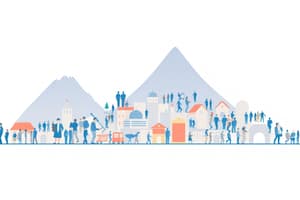Podcast
Questions and Answers
A country with a TFR of 1.5 is most likely experiencing which of the following demographic trends?
A country with a TFR of 1.5 is most likely experiencing which of the following demographic trends?
- A broad-based population pyramid.
- Population decrease. (correct)
- Rapid population growth.
- A stable population size.
Which of the following is NOT a primary factor contributing to population change?
Which of the following is NOT a primary factor contributing to population change?
- Increased birth rates.
- Increased death rates.
- Decreased emigration.
- Changes in resource availability. (correct)
A country in Stage 1 of the Demographic Transition Model is characterized by:
A country in Stage 1 of the Demographic Transition Model is characterized by:
- High birth rates, declining death rates, and rapid population growth.
- High birth rates, high death rates, and a low/decreasing population. (correct)
- Declining birth rates, low death rates, and a declining population.
- Low birth rates, low death rates, and a stable population.
Which stage of the Demographic Transition Model is associated with the highest rates of population growth?
Which stage of the Demographic Transition Model is associated with the highest rates of population growth?
In Stage 3 of the Demographic Transition Model, what are the primary drivers behind the decline in birth rates?
In Stage 3 of the Demographic Transition Model, what are the primary drivers behind the decline in birth rates?
Which characteristic is most indicative of a country in Stage 4 of the Demographic Transition Model?
Which characteristic is most indicative of a country in Stage 4 of the Demographic Transition Model?
What are the key components when considering a population's demographics?
What are the key components when considering a population's demographics?
Which of the following best characterizes 'smart growth' land use planning?
Which of the following best characterizes 'smart growth' land use planning?
What is a primary assumption of urbanists regarding housing and population density?
What is a primary assumption of urbanists regarding housing and population density?
Which of the following is a 'push-away' factor related to immigration?
Which of the following is a 'push-away' factor related to immigration?
Flashcards
Demographics
Demographics
Vital statistics about people, including births, deaths, population density, distribution, size, and age structure.
Urbanization
Urbanization
Increasing concentration of population in cities and transformation of land use to metropolitan patterns.
Total Fertility Rate (TFR)
Total Fertility Rate (TFR)
Average number of children that would be born to a woman over her lifetime if she were to experience the exact current age-specific fertility rates.
Broad Population Pyramid
Broad Population Pyramid
Signup and view all the flashcards
Inverted Population Pyramid
Inverted Population Pyramid
Signup and view all the flashcards
4 Ways Population Changes
4 Ways Population Changes
Signup and view all the flashcards
Demographic Transition Model - Stage 1
Demographic Transition Model - Stage 1
Signup and view all the flashcards
Demographic Transition Model - Stage 2
Demographic Transition Model - Stage 2
Signup and view all the flashcards
Demographic Transition Model - Stage 3
Demographic Transition Model - Stage 3
Signup and view all the flashcards
Demographic Transition Model - Stage 4
Demographic Transition Model - Stage 4
Signup and view all the flashcards
Study Notes
- Key components of demographics include age, reproductive status, gender percentages, socioeconomic status, and total fertility rates (TFR).
Total Fertility Rate (TFR)
- TFR indicates population replacement speed.
- A TFR of 2 suggests a stable population.
- A TFR of 7 indicates overpopulation.
- A TFR of 1.5 suggests population decline.
Population Pyramids
- A broad-based pyramid shape signifies an increasing population, typical of India.
- This is associated with a high TFR (above 2).
- An upside-down pyramid signifies a decreasing population, like in Japan.
- This is associated with a low TFR (below 2).
- A rectangular population shape indicates stability, with a TFR around 2.
Factors Affecting Population Change
- Birth rate increases.
- Immigration increases.
- Emigration decreases.
- Death rate decreases.
World Population
- The world's population is approximately 7.4 billion people.
Infant Mortality Rates & Life Expectancy
- High infant mortality rates combined with low life expectancy often indicate poor healthcare and economic conditions.
- These factors are commonly seen in poorer countries with a lack of hospitals and doctors.
Demographic Transition Model - Stage 1: Primitive Stage
- High birth and death rates.
- Low or decreasing population.
- Conditions of poverty and lack of healthcare prevail.
Demographic Transition Model - Stage 2: Epidemiological Transition Stage
- Decreasing death rates due to advances in medicine and nutrition.
- High birth rates.
- Exponential population increase, representing the highest growth rates in the model.
Demographic Transition Model - Stage 3: Economical/Industrial Stage
- Low death rates.
- Declining birth rates due to cost of raising children, higher living standards, and increased female participation in the workforce/education.
- Population stabilization, slowing down of growth.
Demographic Transition Model - Stage 4: Modern Stability/Post-Industrial
- Examples include Japan, Northern Europe, and Scandinavia.
- Birth rates lower than death rates (TFR below 2).
- Declining population.
Urban Sprawl
- This refers to unexpected, rapid urban growth.
Smart Growth
- Incorporates parks.
- Provides diverse transportation options.
- Includes open space.
- Uses parameters for planned and integrated growth.
Urbanists
- They assume higher housing and population densities.
- They provide ease of transportation.
- They allow for shorter commuting distances to activities/work.
Open Space Ecological Integration
- Planning development around key habitats and ponds.
Global Population Distribution
- The majority of the world's population lives in urban areas.
- Most global urban growth occurs in urban areas in third-world countries (underdeveloped).
Demographics Defined
- Vital statistics about people, including births, deaths, population density, distribution, size, and age structure.
Urbanization Defined
- Increasing population concentration in cities accompanied by a shift to metropolitan land use patterns.
Immigration "Push-Away" Factors
- Overpopulation.
- Economic factors.
- Politics.
- Racial or religious conflicts.
- Land tenure issues.
- Agricultural changes.
Immigration "Pull-In" Factors
- "Excitement and Vitality" in cities.
- Job opportunities.
- Housing availability.
- Entertainment options.
- Social mobility and power.
- Specialization of professions.
Land Use Planning Steps
- Conduct environmental and social inventory (geology, ecosystems, economic, health factors).
- Identify and prioritize goals.
- Develop individual and composite maps using overlays and GIS.
- Create a MASTER composite map indicating variable interactions and suitable land uses.
- Develop a MASTER PLAN with input from experts, officials, and the public.
- Implement the master plan with ongoing monitoring, updates, and revisions.
Studying That Suits You
Use AI to generate personalized quizzes and flashcards to suit your learning preferences.




